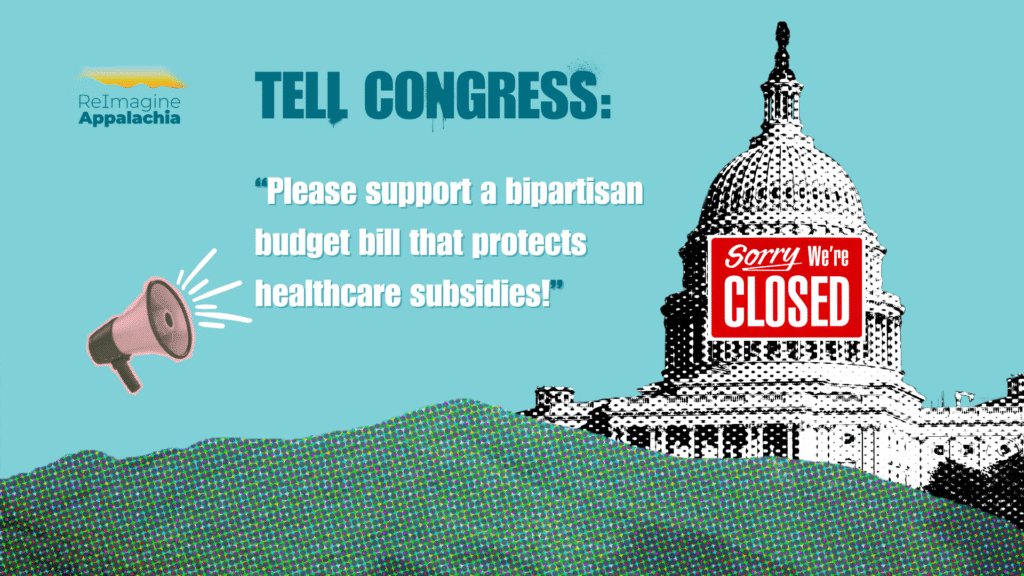
October 24, 2025
We are now closing out the first complete month of the 2025 government shutdown, which is the second longest in history, after the 2018 shutdown, which lasted 35 days. I’m feeling a mix of emotions today, as severe impacts for our families, our neighbors, and many of y’all reading this email right now are taking effect. My heart is warmed by the many emails and texts I’ve received from my children’s public school, reaching out to check and double-check that our family has access to food this weekend and going forward.
By friends who have been furloughed or fired from their work for the federal government, who are now making plans to use their time to volunteer at food pantries and make food deliveries to elderly and homebound folks. By ongoing pride for the hundreds of incredible organizations in our region that work to keep our families and our workers fed. These groups know exactly how hard the next phase of the shutdown is going to be, because they see the faces associated with all the statistics going around every single day. I’m also excited about all the adorable, sweet children in Halloween costumes I’m going to see this evening, as parents, aunts, uncles, grandparents, and neighbors work to provide innocent, happy memories for the little ones in our communities. It’s an incredibly sad and stressful time. But it’s a time when, as Mr. Rogers, one of our favorite Appalachians, famously said, we can look for the helpers. Please be in touch if we can offer support for your work or if there are additional impacts we should cover in these updates.
We’ll keep looking to Congress to see if negotiations open up for a solution to the shutdown. You can encourage them to do so using our easy contact tool.
Take Action Here!
If you want to reach out to your members of Congress about this, we have created an easy tool for you here.
Affordable Care Act (ACA)
It is unlikely that a solution to the shutdown that includes an extension to ACA subsidies will pass before nationwide enrollment opens on November 1. Enrollees are already seeing their premium costs for 2026 rise by thousands of dollars. For those who are concerned about the status of their healthcare.gov plans, you can now preview them. If you’re on Medicare, you can also call 1-800-633-4227.
If a bill passes that extends the ACA subsidies before December 31st or even beyond, people should still have access to those, so people will need to continue to check back for updated premium costs. In most states, people must enroll by Dec. 15 for coverage starting Jan. 1, and by Jan. 15 for coverage starting Feb. 1, though some states have later deadlines.This NPR article has more details.
SNAP has run dry
The Supplemental Nutrition Assistance Program (SNAP) is on track to miss its first payment on November 1. People with remaining balances from their October benefits will continue to have access to them in November. Experts expect beneficiaries to receive benefits retroactively after the government reopens. Gina Plata-Nino, interim SNAP director at the Food Research & Action Center, has said that federal stipulations should ensure that people recoup missed benefits. The US Department of Agriculture (USDA) says it will not tap into its $6 billion contingency fund to sustain food benefits through November.
Democrat Senate Minority Leader Chuck Schumer said Wednesday that Democrats would vote for Republican Sen. Josh Hawley’s bill to fund SNAP during the government shutdown. Hawley’s proposed bill now has 10 Republican co-sponsors. Democratic Sen. Ben Ray Luján introduced a competing bill Wednesday to fund SNAP and the Special Supplemental Nutrition Program for Women, Infants, and Children (WIC). Lujan’s bill is co-sponsored by the entire Senate Democratic caucus.
The USDA has also decided to cancel its annual Household Food Security report, which has been in place for 30 years to inform policy decisions by gathering food insecurity data. Without this report, it will undoubtedly be more difficult to ensure sufficient food benefits to places where they are most needed.
ReImagine’s Programs Director, Dana Kuhnline, speaks with Joe Kennedy, Founder at Groundwork Project, about how the 2025 shutdown is likely to impact Appalachian communities. Watch the full interview here.
Safety workers are working without pay
The Labor Department is requiring more than 950 mining safety agency workers to resume duties labelled as “necessary to protect life and property”. Many workers must continue conducting on-site inspections to prevent accidents, mine collapses, and other hazardous events.
Agencies like the Occupational Safety and Health Administration (OSHA) and the Mine Safety and Health Administration (MSHA) are already understaffed and under-resourced after significant DOGE cuts and workforce thinning earlier this year, putting miners at greater risk of developing respiratory diseases like black lung and silicosis. Almost half of the MSHA staff, and a significant of OSHA employees are reportedly furloughed.
Disaster Resilience in the Shutdown
NOAA, the National Weather Service, and FEMA are already operating at reduced capacity. Most National Weather Service forecasters are considered emergency employees and must continue working without pay through the shutdown. Money for FEMA is already dwindling, and additional funding would need congressional approval.
With just over a month left of hurricane season, the shutdown increases risk due to less accurate weather tracking and reduced ability to respond.Another related impact is the National Flood Insurance Program (NFIP) is on pause, meaning that those buying homes in flood zones have reduced options.
The question of back pay
While furloughed workers can take advantage of unemployment benefits during the shutdown, essential workers (who must continue carrying out duties) cannot. States are advising government workers to carefully prioritize their personal spending for the coming weeks. On October 7, Trump threatened to withhold reimbursement to some furloughed workers who he says don’t “ deserve” back pay after a government reopening. During the last shutdown in 2019, Congress passed the Government Employee Fair Treatment Act, which states that employees furloughed during lapses in government funding “shall be paid for the period of the lapse.”
Sigh of relief for 4,000 + federal employees
U.S. District Judge Susan Illston in San Francisco has indefinitely blocked the Trump administration from firing federal employees as of the start of the shutdown Oct. 1. Judge Illston said that her order does not apply to notices sent before the shutdown. Judge Illston also backed labor union claims that the cuts were arbitrary and politically motivated.
The Department of Energy has told employees to avoid using certain words, including “climate change,” “green” and “sustainable”.
Head Start programs nationwide are facing shortfalls.
Head Start is a United States Department of Health and Human Services program that provides education, health, and nutrition services to low-income children and families.
More than a half-dozen Head Start programs have already missed federal disbursements they were expecting Oct. 1, but have continued operating with dwindling reserves or with local government aid. The National Head Start Association released data on how many of the 1,600 programs nationwide will be impacted if no solution comes about. One hundred and thirty-four programs across 41 states and Puerto Rico may not receive funding, impacting 65,000 children. If they cannot supplement lost funds, many of the 134 programs will likely close.
Americorps employees working without pay
Many AmeriCorps members are already missing paychecks and will continue to accrue but not receive allowance payments until the government returns to normalcy. This applies to Volunteers in Service to America (VISTA) members and National Civilian Community Corps (NCCC) members. VISTA personnel who are categorized as “cost-share” members (meaning their allowances are paid through organizations instead of directly by the federal government) will continue to receive payments. Non-traditional NCCC members like those serving in FEMA Corps and Forest Corps will continue to receive their living allowance as scheduled.
Tell your members of Congress about local impacts.
It continues to be important to let our members of Congress know about the real world impacts of the government shutdown. You can use our email tool to quickly personalize and send a message to representatives today with this link.

